Cigarette Cards
Air Raid Precautions 1938
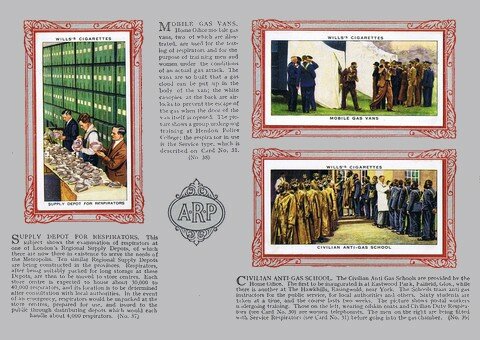
SUPPLY DEPOT FOR RESPIRATORS. This subject shows the examination of respirators at one of London's Regional Supply Depots, of which there are now three in existence to serve the needs of the Metropolis. Ten similar Regional Supply Depots are being constructed in the provinces. Respirators after being suitably packed for long storage at these Depots, are then to be moved to store centres. Each centre is expected to house about 30,000 to 40,000 respirators, and its location is to be determined after consultation with local authorities. In the event of an emergency, respirators would be unpacked at the store centres, prepared for use, and issued to the public through distributing depots which would each handle about 4,000 respirators. (No.37)
MOBILE GAS VANS. Home Office mobile gas vans, two of which are illustrated, are used for the testing of respirators and for the purpose of training men and women under the conditions of an actual gas attack. The vans are so built that a gas cloud can be put up in the body of the van; the white canopies at the back are airlocks to prevent the escape of the gas when the door of the van itself is opened. The picture shows a group undergoing training at Hendon Police College; the respirator in use is the Service type, which is described on Card No. 31. (No.38)
CIVILIAN ANTI-GAS SCHOOL. The Civilian Anti Gas Schools are provided by the Home Office. The first to be inaugurated is at Eastwood Park, Falfield, Glos. while there is another at The Hawkhills, Easingwold, near York. The Schools train anti-gas instructors for the public service, for local authorities and others. Sixty students are taken at a time, and the course lasts two weeks. The picture shows postal workers undergoing training. Those on the left, wearing oilskin coats and Civilian Duty Respirators (see Card No. 30) are women telephonists. The men on the right are being fitted with Service Respirators (see Card No. 31) before going into the gas chamber. (No.39)
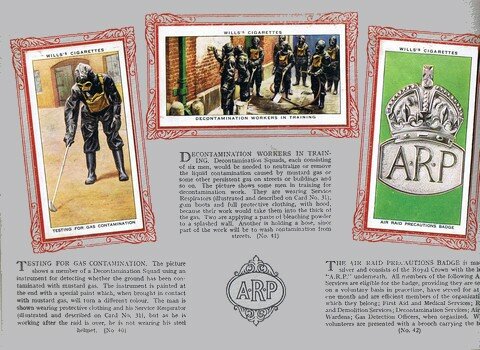
TESTING FOR GAS CONTAMINATION. The picture shows a member of a Decontamination Squad using an instrument for detecting whether the ground has been contaminated with mustard gas. The instrument is painted at the end with a special paint which, when brought in contact with mustard gas, will turn a different colour. The man is shown wearing protective clothing and his Service Respirator (illustrated and described on Card No. 31), but as he is working after the raid is over, he is not wearing his steel helmet. (No.40)
DECONTANIMATION WORKERS IN TRAINING. Decontamination Squads, each consisting of six men, would be needed to neutralize or remove the liquid contamination caused by mustard gas or some other persistent gas on streets or buildings and so on. The picture shows some men in training for decontamination work. They are wearing Service Respirators (illustrated and described on Card No. 31), gum boots and full protective clothing, with hood, because their work would take them into the thick of the gas. Two are applying a paste of bleaching powder to a splashed wall. Another is holding a hose, since part of the work will be to wash contamination from streets. (No.41)
THE AIR RAID PRECAUTIONS BADGE is made of silver and consists of the Royal Crown with the letters "A.R.P." underneath. All members of the following A.R.P. Services are eligible for the badge, providing they are serving on a voluntary basis in peacetime, have served for at least one month and are efficient members of the organization to which they belong; First Aid and Medical Services; Rescue and Demolition Services; Decontamination Services; Air Raid Wardens; Gas Detection Officers, when organized. Women volunteers are presented with a brooch carrying the badge. (No. 42)
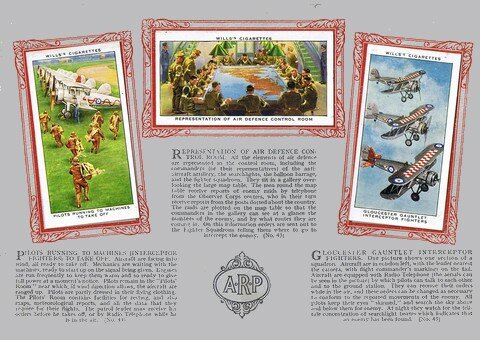
REPRESENTATION OF AIR DEFENCE CONTROL ROOM. All the elements of air defence are represented in the control room, including the commanders (or their representatives) of the anti-aircraft artillery, the searchlights, the balloon barrage and the fighter squadrons. They sit in a gallery overlooking the large map table. The men round the map table receive reports of enemy raids by telephone from the Observer Corps centres, who in their turn receive reports from the posts dotted about the country. The raids are plotted on the map table so that the commanders in the gallery can see at a glance the numbers of the enemy, and by what routes they are coming in. On this information orders are sent out to the Fighter Squadrons telling them where to go to intercept the enemy. (No.43)
PILOTS RUNNING TO MACHINES (INTERCEPTOR FIGHTERS) TO TAKE OFF. Aircraft are facing into wind, all ready to take off. Mechanics are waiting with the machines, ready to start up on the signal being given. Engines are run frequently to keep them warm and so ready to give full power at a moment's notice. Pilots remain in the "Pilots' Room" near which, if wind direction allows, the aircraft are ranged up. Pilots are partly dressed in their flying clothing. The Pilots' Room contains facilities for resting, and also maps, meteorological reports, and all the data that they require for their flights. The patrol leader may receive his orders before he takes off, or by Radio Telephone while he is in the air. (No. 44)
GLOUCESTER GAUNTLET INTERCEPTOR FIGHTERS. Our picture shows one section of a squadron. Aircraft are in echelon left, with the leader nearest the camera, with flight commander's markings on the tail. Aircraft are equipped with Radio Telephone (the aerials can be seen in the picture) by which pilots can talk to each other and to the ground station. They can receive their orders while in the air, and these orders can be changed as necessary to conform to the reported movements of the enemy. All pilots keep their eyes "skinned," and search the sky above and below them for enemy. At night they watch for the tell-tale concentration of searchlight beams which indicates that an enemy has been found. (No.45)
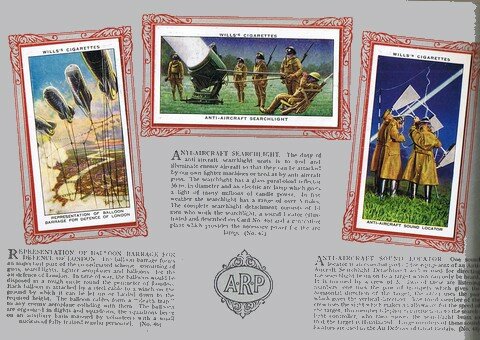
REPRESENTAION OF BALLOON BARRAGE FOR DEFENCE OF LONDON. The balloon barrage forms an important part of the co-ordinated scheme - consisting of guns, searchlights, fighter aeroplanes and balloons - for the air defence of London. In time of war, the balloons would be disposed in a rough circle round the perimeter of London. Each balloon is attached by a steel cable to a winch on the ground by which it can be let up or hauled down to the required height. The balloon cables form a "death trap" to any enemy aeroplane colliding with them. The balloons are organized in flights and squadrons, the squadrons being on an auxiliary basis manned by volunteers with a small nucleus of fully trained regular personnel. (No.46)
ANTI-AIRCRAFT SEARCHLIGHT. The duty of anti-aircraft searchlight units is to find and illuminate enemy aircraft so that they can be attacked by our own fighter machines or fired at by anti-aircraft guns. The searchlight has a glass paraboloid reflector 36 inches in diameter and an electric arc lamp which gives a light of many millions of candle power. In fine weather the searchlight has a range of over 5 miles. The complete searchlight detachment consists of 10 men who work the searchlight, a sound locator (illustrated and described on Card No. 48) and a generating plant which provides the necessary power for the arc lamp. (No.47)
ANTI-AIRCRAFT SOUND LOCATOR. One sound locator is an essential part of the equipment of an Anti-Aircraft Searchlight Detachment and is used for directing the searchlight beam, on to a target which can only be heard. It is manned by a crew of 3. Two of these are listening numbers, one uses the pair of trumpets which gives the horizontal direction of the target, the other uses the pair which gives the vertical direction. The third member of the crew uses the sight which makes an allowance for the speed of the target; this member telephones instructions to the searchlight controller, who then moves the searchlight beam so that the target is illuminated. Large numbers of these sound locators are used in the Air Defence of Great Britain. (No.48)
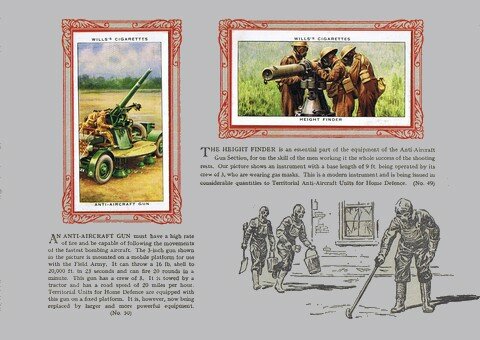
THE HEIGHT FINDER is an essential part of the equipment of the Anti-Aircraft Gun Section, for on the skill of the men working it the whole success of the shooting rests. Our picture shows an instrument with a base length of 9 ft. being operated by its crew of 3, who are wearing gas masks. This is a modern instrument and is being issued in considerable quantities to Territorial Anti-Aircraft Units for Home Defence. (No.49)
AN ANTI-AIRCRAFT GUN must have a high rate of fire and be capable of following the movements of the fastest bombing aircraft. The 3-inch gun shown in the picture is mounted on a mobile platform for use with the Field Army. It can throw a 16 lb. shell to 20,000 ft. in 23 seconds and can fire 20 rounds in a minute. This gun has a crew of 8. It is towed by a tractor and has a road speed of 20 miles per hour. Territorial Units for Home Defence are equipped with this gun on a fixed platform. It is, however, now being replaced by larger and more powerful equipment. (No.50)

